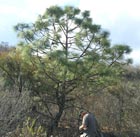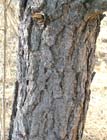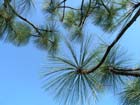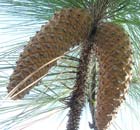Pinus devoniana
Lindley 1839
Common names
Pino lacio, tsihiréen, pino escobetón, ocote gretado, pino blanco (CONABIO 2009); Michoacan pine.
Taxonomic notes
This magnificent pine belongs to subsection Ponderosae, which it shares with 13 other large, forest-dominant pines of the western U.S. and Mexico; see the "Taxonomic notes" for Pinus ponderosa for further discussion. The type location is Mexico: Hidalgo: Cerro Ocotillo, "found on the Ocotillo between Real del Monte and Regla." Collected by Hartweg (s.n.) in 1838.
Synonymy (Farjon and Styles 1997):
- Pinus macrophylla Lindley 1839
- Pinus montezumae A. B. Lambert var. macrophylla (Lindley) Parlatore in Candolle 1868.
- Pinus filifolia Lindley 1839
- Pinus grenvilleae G. Gordon 1847
- Pinus wincesteriana G. Gordon 1847
- Pinus michoacaensis Roezl 1857
- Pinus magnifica Roezl 1857
- Pinus ocampii Roezl 1857
- Pinus zitacuarensis Roezl 1857
- Pinus nee-plus-ultra Roezl 1858
- Pinus zitacuarensis Roezl var. nitida Roezl ex Carriere 1867
- Pinus verschaffeltii Roezl ex Carriere 1867
- Pinus pawlowskiana Roezl ex Carriere 1867
- Pinus michoacana Martínez 1944
- Pinus michoacana Martínez var. cornuta Martínez 1944
- Pinus michoacana Martínez var. quevedoi Martínez 1944
- Pinus michoacana Martínez var. cornuta Martínez forma nayaritana Martínez 1948
- Pinus michoacana Martínez forma procera Martínez 1948
- Pinus michoacana Martínez forma tumida Martínez 1948
Although this is a daunting list, the only one you are likely to encounter is P. michoacana Martínez, or one of the many varieties and formae of P. michoacana described by Martínez.
Farjon and Styles (1997) note that "intermediates occur between this taxon and P. montezumae, with characters of either species shared in populations of one or the other" and cite Shaw (1909) and Carvajal and McVaugh (1992) in referring to a "montezumae" group, that includes these two species as well as P. hartwegii.
Description
Trees to 20-30 m tall and 80-100 cm dbh, usually with a single erect trunk. The open, broad pyramidal or domed crown is formed by long, spreading or ascending first-order branches with sparse, spreading and ascending higher-order branches. Bark red-brown to dark brown, rough, with age forming elongated plates divided by deep longitudinal black fissures. Shoots 15-20 mm thick, rigid, rough and scaly, with persistent, decurrent pulvini. Terminal foliar buds 20-40 mm long, laterals smaller, ovoid-acute, not resinous; the scales imbricate, orange-brown to red-brown, with ciliate margins. Foliar units in dense tufts toward the ends of upturned branches. Fascicle sheaths up to 30-40 mm long, persistent. Needles in fascicles of 5, persisting 2-3 years, varying from rigid and straight to flexible and drooping, (17-)25-40(-45) cm × 1.1-1.6 mm, acute-pungent, bright, lustrous (dark) green, with stomata on all faces 5-9 lines on the abaxial face and 3-6 lines on each adaxial face. Pollen cones crowded near proximal ends of new shoots, subtended by long, subulate bracts with ciliate margins, cylindrical, 20-40 mm long, pink-purple turning light brown. Seed cones subterminal, whorled in groups of 1-4. Immature cones often erect, after pollination recurving on thick, bracteate peduncles, ovoid-oblong, purple-brown, maturing in two years. Mature cones on short, persistent peduncles, leaving a few scales on the branch when falling, typically ovoid-oblong with an oblique base, 15-35 × 8-15 cm when open, opening at maturity. Seed scales 175-225, apophysis raised, transversely keeled, rhombic with irregular sides, up to 25 mm wide, brown. Umbo dorsal; raised, flat or depressed; up to 7 mm wide, terminating in a small, usually deciduous prickle, grey-brown. Seeds obliquely broad ovoid, flattened, 8-10 × 5-7 mm, light brown, often with dark spots. Seed wings articulate, obliquely ovate to oblong, 25-35 × 10-15 mm, light brown with darker stripes. It can be distinguished from similar species, such as P. montezumae, by "its thick, shaggy branches, its long and stiff, lustrous green leaves with very long, dark, resinous fascicle sheaths, and the very large, thick woody cones" (Farjon and Styles 1997).
Distribution and Ecology
Mexico: Aguascalientes, Chiapas, Distrito Federal, Guerrero, Hidalgo, Jalisco, México, Michoacán, Morelos, Nayarit, Oaxaca, Puebla, Querétaro, San Luis Potosí, Sinaloa, Tlaxcala, Veracruz, Zacatecas; and the southern highlands of Guatemala Perry 1991, Farjon and Styles 1997). See also Thompson et al. (1999) (as P. michoacana).
The map below does not show the full distribution as currently known; it omits the populations in Guatemala.
Distribution data from USGS (1999).
P. devoniana is found at altitudes of (700-)900-2500(-3000) m in areas with a warm-temperate to subtropical climate and precipitation of 1000-1500 mm per year with a November-May dry season. It occurs on a wide variety of soils. Its principal habitat is open pine-oak forest; fire is relatively common in these settings and P. devoniana has a number of adaptations for fire, such as a juvenile "grass stage" similar to that of P. palustris of the SE United States. Common associates vary from north to south and include P. oocarpa, P. montezumae, P. pseudostrobus, and P. maximinoi, as well as P. cembroides at lower altitudes and P. hartwegii at higher altitudes. Associated flowering plants include Quercus spp., and Liquidambar spp., and understory shrubs such as Calliandra, Leucaena, Acacia, Dodonaea, Gaultheria, and Mimosa (Farjon and Styles 1997).
Hardy to Zone 9 (cold hardiness limit between -6.6°C and -1.1°C) (Bannister and Neuner 2001).
Remarkable Specimens
Ethnobotany
The wood is of good quality, and is for joinery, furniture, boards, parquet, firewood; and
pulp and resin production (CONABIO 2009). CONABIO (2009) provides further detail on management of this species for economic uses.
Observations
The species can be seed widely within its range. I found memorable examples growing at the ruins of Monte Alban by Oaxaca city, in the foothills around Nevado de Colima, and in the vicinity of Uruapan, but it seems to be locally common throughout most of its range.
Remarks
The epithet honors the 6th Duke of Devonshire, William Cavendish (1790-1858), an avid gardener.
This species is a principal host to the dwarf mistletoes Arceuthobium aureum subsp. petersonii (in Oaxaca and Chiapas), A. durangense (in Durango, Sinaloa and Jalisco), A. globosum subsp. grandicaule (in southern Mexico), and A. oaxacanum (rare, in Oaxaca) (Hawksworth and Wiens 1996). In Sinaloa, it is also parasitized by the mistletoe Psittacanthus macrantherus Eichl. (Howell et al. 2006).
Insect pests afflicting P. devoniana include defoliating insects (Neodiprion), the bark insects Ips sp., Dendroctonus sp., Rhyacionia sp. and Pissodes sp., as well as the Pityophthorus borer. The cones are attacked by Conophthorus michoacan and Megastigmus albifrons. Cydia sp. and Dioryctria erythropasa afflict the seed (CONABIO 2009).
After a reasonably thorough literature search, it now appears that no one writing in English has yet said anything, apart from formal scientific reporting, about this pine. I am sure that something has been written in Spanish, because at its best it is one of the most elementally Mexican of pines. When my mind wanders to the subtropical savannas of Michoacán, they are populated by herds of this pine, mostly clustering on small topographic rises or the foothills of mountains, where they can find a bit more rain and perhaps a bit less salt in the soil. These trees project a sense of vigorous strength, for though not generally very large, they are robust, with thick branches and twigs, and large foliar units of very long, often drooping needles. Long, drooping needles seem to me to be the most characteristic feature of Mexican pines, for they are almost a fixture on the Mexican landscape (and I mean here to include Central America, though I haven't traveled there yet), and in a way this pine of Michoacan reminds me of the P. monophylla forests of the North, except transported to a subtropical landscape.
Although I live in the world's most spectacular conifer forest (the northwest coast of North America), at heart I am a desert rat, and most of my favorite conifers live in the desert. Of course, you must understand that to a conifer, 300 mm of rain a year is a desert. There are plenty of deserts that receive less than 100 mm a year, but they have no conifers. Still, 300 mm is pretty dry, and it doesn't produce a very fat land. These trees live as glorified shrubs. I do not mean that they are shrubs in the botanical sense, but I do mean that they mostly consist of a root system and a crown, with a minimal length of trunk connecting the two. They are glorified by being large; the grandest of these trees are over 20 m tall with a crown spread of over 20 m, and I believe there are one or two Cupressus that would exceed 30 m.
The Michoacan pine (I dislike the name P. devoniana; in a just world this species would be named for its homeland), and all its fellow conifers that struggle for life in the vast dry places of the Earth are also such trees. Ecologically, they have found a way to live in their dry habitat that allows them to conserve water using both tolerance and avoidance strategies, and in the process they support large biomass loadings of live tissue, and effectively avoid or tolerate the stresses imposed by fire, grazing animals, pestilence, fungi, and even the occasional mistletoe. They do this in a manner similar to that employed by the other dry-site trees in the Pinaceae (such as the piñons, P. maximinoi, various mountain pines such as P. flexilis, and a very few larches, firs and spruces such as L. potaninii, A. pinsapo or P. pungens), and really not too different from that used by Callitris, Cupressus and Juniperus, three genera that have been very successful in the desert.
In fact, the biggest ecological difference between the desert representatives of the pines and of the other genera I've mentioned, is that the pines have been far and away the most successful in developing strategies to endure or even to benefit from fires. By the way, another genus that has been very successful on this front is Quercus, and it is no surprise that Pinus and Quercus together seem to dominate most of the forest ecosystems of Mexico, the Mediterranean, and indeed of every other landscape where it is wet enough to produce a continuous cover of plant biomass, and yet dry enough to set that biomass ablaze every few years. In this environment the pines and oaks feed and yet survive the fire, in the process excluding species less adapted to the burning desert.
In this connection, I would like to explain the grass stage. The best summary I have found is that presented by Mirov (1967), which I here summarize: Certain pine species have a juvenile life stage characterized by a height growth inhibition in which the seedling develops secondary foliage but the shoot does not elongate. The plant looks like a bunchgrass. The seedling usually remains in this stage, meanwhile developing a large taproot, and then, especially in response to an increase in available light (such as may be caused by a fire), commences rapid height growth. In 1948 Mirov grafted the bud of a grass-stage pine (P. palustris) onto the root of a species that doesn't have a grass stage (P. elliottii). The resulting plant continued in the grass stage for another 10 years. Brown (1958) determined that the buds of plants that are in the grass stage produce no auxin. He was evidently a persistent chap, coauthoring what seems to be the most recent study of the problem, by Nelson et al. (2003). That study suggests that a minimum of 4 to 10 different genes are involved in producing the grass stage, and infers "that the grass stage has evolved through the accumulation of alleles at several loci, each with small effects on various components of first-year height growth." This could be consistent with the hypothesis that the grass stage has independently evolved several times over the history of the subgenus Pinus. It could also be consistent with the hypothesis that it has evolved so many times that the genes necessary to trigger it are fairly common in the subgenus, and simply have to increase in frequency for the trait to be expressed.
The grass stage has been reported for these pines: P. devoniana, P. elliottii var. densa, P. engelmannii, P. merkusii, P. montezumae, P. palustris, P. pseudostrobus, and P. tropicalis. This suite of species represents three different subsections of subgenus Pinus (Mirov 1967).
Citations
Brown, Claud L. 1958. Studies in the auxin physiology of longleaf pine seedlings. Pp. 511-525 in K. V. Thimann (ed.), The Physiology of Forest Trees. New York: The Ronald Press.
Carvajal, S. and R. McVaugh. 1992. Pinus L. In R. McVaugh, Flora Novo-Galiciana 17:32-100. Ann Arbor: University of Michigan Herbarium.
CONABIO. 2009. Pinus devoniana. http://www.conafor.gob.mx/portal/docs/secciones/reforestacion/Fichas%20Tecnicas/Pinus%20devoniana.pdf, accessed 2009.11.12, now defunct.
Howell, B., S. Kenaley, and R. Mathiasen. 2006. First Report of Psittacanthus macrantherus on Pinus devoniana and Quercus castanea in Mexico. Plant Diseases 90:1461.
Lindley. 1839. Edwards's Botanical Register 25:62. No illustration; here is the full text:
"96. PINUS Devoniana; pentaphylla, foliis longissimis, ramis crassissimis, strobilis pendulis solitariis corniformibus obtusis: squamis apice rotundatis rhomboideis linea transversa paulo elevata opacis griseis medio abrupte umbonatis obtusis laevigatis, seminibus obovatis ala nigricante quintuplo brevioribus.
This noble species is the "Pino blanco," or "P. real," of the Mexicans. Mr. Hartweg describes it as a hardy tree from 60 to 80 feet high, found on the Ocotillo between Real del Monte and Regla. The cones are from nine to ten inches long, curved, about three inches in diameter near the base, and tapering till they are not more than one inch and three-quarters broad at the point. The young shoots are nearly an inch in diameter, and look very like those of Pinus palustris. It is worthy of bearing the name of His Grace the Duke of Devonshire, whose arboretum at Chatsworth will it is to be hoped be soon augmented by this truly regal plant."
Nelson, C. D., C. Weng, T. L. Kubislak, M. Stine, and C. L. Brown. 2003. On the number of genes controlling the grass stage in longleaf pine. Journal of Heredity 94(5):392-398.
See also
Musálem, M. A. and O. Sánchez-Cruz. 2003. Monografía de Pinus michoacana Martínez. Sagarpa-INIFAP CONABIO, Chapingo, México.
Sáenz-Romero, C., and B. L. Tapia-Olivares. 2008. Genetic variation in frost damage and seed zone delineation within an altitudinal transect of Pinus devoniana (P. michoacana) in Mexico. Silvae Genetica 57(3):165-170.







